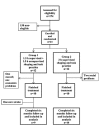Similar Effects of Two Modified Constraint-Induced Therapy Protocols on Motor Impairment, Motor Function and Quality of Life in Patients with Chronic Stroke
- PMID: 26294941
- PMCID: PMC4508540
- DOI: 10.4081/ni.2015.5430
Similar Effects of Two Modified Constraint-Induced Therapy Protocols on Motor Impairment, Motor Function and Quality of Life in Patients with Chronic Stroke
Abstract
Modified constraint-induced movement therapy (CIMT) protocols show motor function and real-world arm use improvement. Meanwhile it usually requires constant supervision by physiotherapists and is therefore more expensive than customary care. This study compared the preliminary efficacy of two modified CIMT protocols. A two-group randomized controlled trial with pre and post treatment measures and six months follow-up was conducted. Nineteen patients with chronic stroke received 10 treatment sessions distributed three to four times a week over 22 days. CIMT3h_direct group received 3 hours of CIMT supervised by a therapist (n=10) while CIMT1.5h_direct group had 1.5 hours of supervised CIMT+1.5 hours home exercises supervised by a caregiver (n=9). Outcome measures were the Fugl-Meyer Assessment, the Motor Activity Log, and the Stroke Specific Quality of Life Scale. The modified CIMT protocols were feasible and well tolerated. Improvements in motor function, real-world arm use and quality of life did not differ significantly between treated groups receiving either 3 or 1.5 hours mCIMT supervised by a therapist.
Keywords: modified constraint-induced therapy; motor impairment and function; quality of life; stroke.
Conflict of interest statement
Conflict of interest: the authors declare no potential conflict of interest.
Figures


References
-
- Feigin VL, Lawes CMM, Benett DA, Anderson CS. Stroke epidemiology: a review of population-based studies of incidence, prevalence, and case-fatality in the last 20th century. Lancet Neurol 2003;2:43–53. - PubMed
-
- Gresham GE, Alexander D, Bishop DS, et al. American Heart Association prevention conference. IV. Prevention and rehabilitation of stroke. Rehabilitation. Stroke 1997;28:1522–6. - PubMed
-
- Sarti C, Rastenyte D, Cepaitis Z, Tuomiletho J. International trends in mortality from stroke, 1968–1994. Stroke 2000;31:1588–601. - PubMed
-
- Curioni C, Cunha CB, Veras RP, Andre C. The decline in mortality from circulatory diseases in Brazil. Rev Panam Salud Publica 2009;25:9–15. - PubMed
LinkOut - more resources
Full Text Sources
Other Literature Sources
